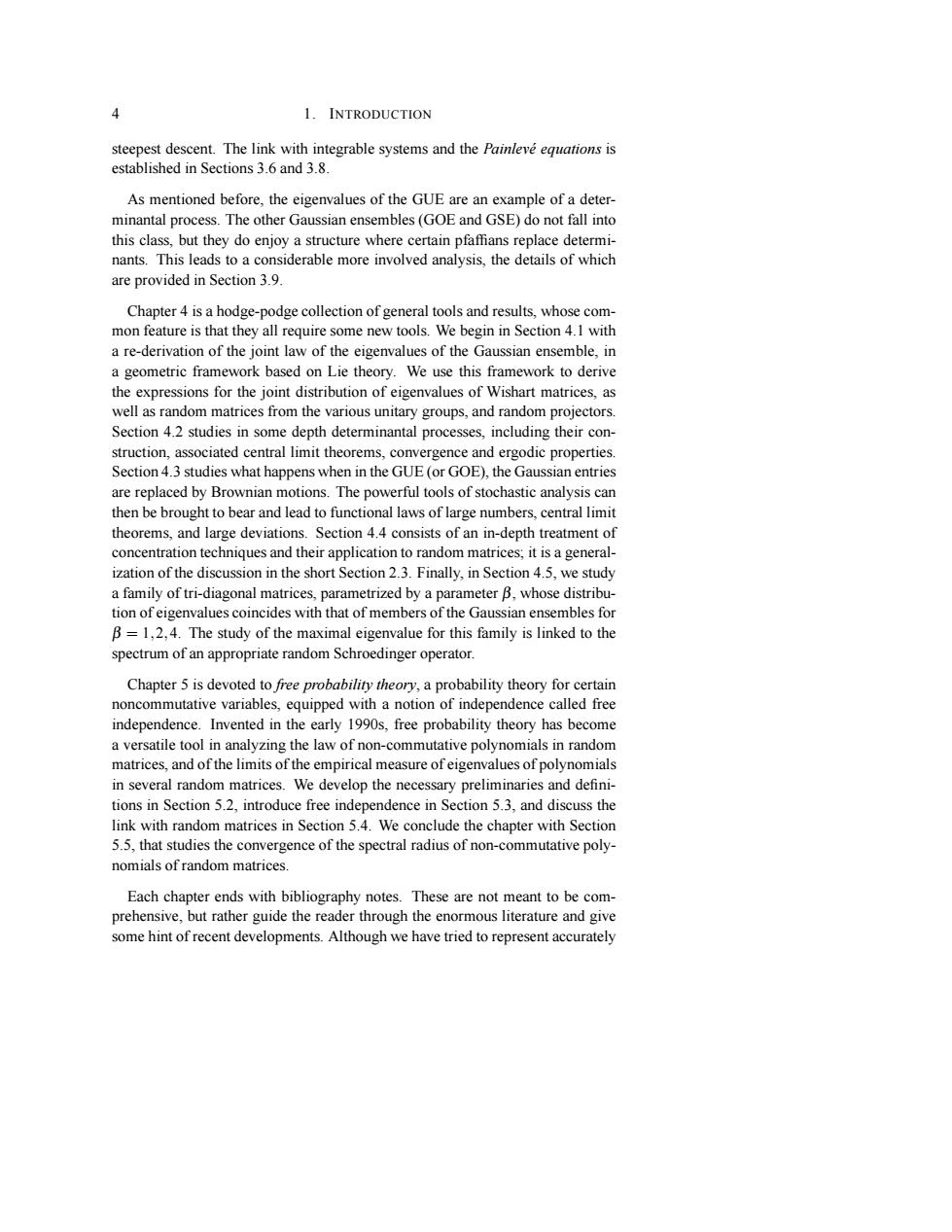正在加载图片...

1.INTRODUCTION steepest descent.The link with integrable systems and the Painleve eguations is established in Sections 3.6 and 3.8. As mentioned before,the eigenvalues of the GUE are an example of a deter- minantal process.The other Gaussian ensembles (GOE and GSE)do not fall into this class,but they do enjoy a structure where certain pfaffians replace determi- nants.This leads to a considerable more involved analysis,the details of which are provided in Section 3.9. Chapter 4 is a hodge-podge collection of general tools and results,whose com- mon feature is that they all require some new tools.We begin in Section 4.1 with a re-derivation of the joint law of the eigenvalues of the Gaussian ensemble,in a geometric framework based on Lie theory.We use this framework to derive the expressions for the joint distribution of eigenvalues of Wishart matrices,as well as random matrices from the various unitary groups,and random projectors. Section 4.2 studies in some depth determinantal processes,including their con- struction,associated central limit theorems,convergence and ergodic properties. Section 4.3 studies what happens when in the GUE(or GOE),the Gaussian entries are replaced by Brownian motions.The powerful tools of stochastic analysis can then be brought to bear and lead to functional laws of large numbers,central limit theorems,and large deviations.Section 4.4 consists of an in-depth treatment of concentration techniques and their application to random matrices;it is a general- ization of the discussion in the short Section 2.3.Finally,in Section 4.5,we study a family of tri-diagonal matrices,parametrized by a parameter B,whose distribu- tion of eigenvalues coincides with that of members of the Gaussian ensembles for B=1,2,4.The study of the maximal eigenvalue for this family is linked to the spectrum of an appropriate random Schroedinger operator. Chapter 5 is devoted to free probability theory,a probability theory for certain noncommutative variables,equipped with a notion of independence called free independence.Invented in the early 1990s.free probability theory has become a versatile tool in analyzing the law of non-commutative polynomials in random matrices,and of the limits of the empirical measure of eigenvalues of polynomials in several random matrices.We develop the necessary preliminaries and defini- tions in Section 5.2,introduce free independence in Section 5.3.and discuss the link with random matrices in Section 5.4.We conclude the chapter with Section 5.5,that studies the convergence of the spectral radius of non-commutative poly- nomials of random matrices. Each chapter ends with bibliography notes.These are not meant to be com- prehensive,but rather guide the reader through the enormous literature and give some hint of recent developments.Although we have tried to represent accurately4 1. INTRODUCTION steepest descent. The link with integrable systems and the Painleve equations ´ is established in Sections 3.6 and 3.8. As mentioned before, the eigenvalues of the GUE are an example of a determinantal process. The other Gaussian ensembles (GOE and GSE) do not fall into this class, but they do enjoy a structure where certain pfaffians replace determinants. This leads to a considerable more involved analysis, the details of which are provided in Section 3.9. Chapter 4 is a hodge-podge collection of general tools and results, whose common feature is that they all require some new tools. We begin in Section 4.1 with a re-derivation of the joint law of the eigenvalues of the Gaussian ensemble, in a geometric framework based on Lie theory. We use this framework to derive the expressions for the joint distribution of eigenvalues of Wishart matrices, as well as random matrices from the various unitary groups, and random projectors. Section 4.2 studies in some depth determinantal processes, including their construction, associated central limit theorems, convergence and ergodic properties. Section 4.3 studies what happens when in the GUE (or GOE), the Gaussian entries are replaced by Brownian motions. The powerful tools of stochastic analysis can then be brought to bear and lead to functional laws of large numbers, central limit theorems, and large deviations. Section 4.4 consists of an in-depth treatment of concentration techniques and their application to random matrices; it is a generalization of the discussion in the short Section 2.3. Finally, in Section 4.5, we study a family of tri-diagonal matrices, parametrized by a parameter β, whose distribution of eigenvalues coincides with that of members of the Gaussian ensembles for β = 1,2,4. The study of the maximal eigenvalue for this family is linked to the spectrum of an appropriate random Schroedinger operator. Chapter 5 is devoted to free probability theory, a probability theory for certain noncommutative variables, equipped with a notion of independence called free independence. Invented in the early 1990s, free probability theory has become a versatile tool in analyzing the law of non-commutative polynomials in random matrices, and of the limits of the empirical measure of eigenvalues of polynomials in several random matrices. We develop the necessary preliminaries and definitions in Section 5.2, introduce free independence in Section 5.3, and discuss the link with random matrices in Section 5.4. We conclude the chapter with Section 5.5, that studies the convergence of the spectral radius of non-commutative polynomials of random matrices. Each chapter ends with bibliography notes. These are not meant to be comprehensive, but rather guide the reader through the enormous literature and give some hint of recent developments. Although we have tried to represent accurately